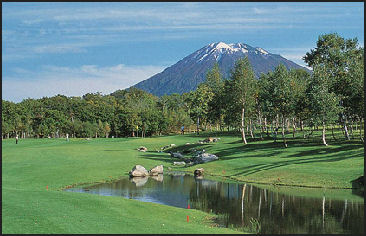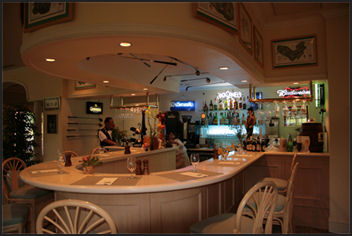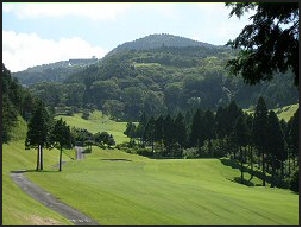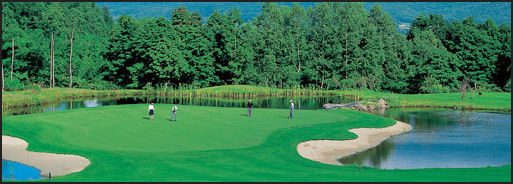RECREATIONAL GOLF IN JAPAN

Japan has the second largest golf market in the world after the United States. There are around 10 million golfers and 2,450 golf courses in Japan (compared to 25 million golfers and 13,600 golf courses in the United States). Around $3 billion in golf equipment is sold every year.
In 2002, 8.86 million people played at least one round of golf in Japan. The number of golfers in Japan is expected to drop to 6.7 million in 2015. The average age of golfers is increasing as relatively young people are taking an interest in the other sports.
The first golf course in Japan opened at Rokkosan, Hyogo Prefecture in 1901. Some say Japan s golfing boom began in 1957 when Japanese golf legend Torakichi Nakamura won the Canada Cup, the forerunner of the Golf World Cup, in 1957, beating Sam Snead and Gary Player. In the 1970s, Japan experienced a golf boom as the Japanese became more affluent. The number of clubs grew from 1,496 in 1985 to 2,458 in 2003, with the sport reaching the peak of its popularity during the "company golf" craze in the late 1980s and early 1990s when the number of new golfers reached at one million a year.
Playing golf is often an all day affair in Japan. Many golfers have to drive several hours to get to a course. Once they are there they play very slowly, an average of 5½ hours per game. By contrast most American can reach a course in 15 minutes and often can play 18 holes within three hours.
Some Japanese golf courses have automatic, radio-controlled robot caddies that move golf bags from to hole to hole on monorails. Others have escalators on steep slopes. Many of the caddies are women who wear blue uniforms and towels and huge bonnets on their head. Japan is also full of multi-story driving ranges.
In April 2010, a golfer burned up the back nine literally when a spark set off by striking the ball with a five iron ignited a fire in extremely dry grass at a course in Sendai that burned 900 square meters of fairway.
Good Websites and Sources: Ex-Pat Site on Golf in Japan /blog.gaijinpot.com/living-guide ; Personal Account of Playing Golf in Japan japanvisitor.blogspot.com ; Golf in Japan (membership site) Golf in Japan ; Golf Courses in Japan Worldgolf.com ; Tokyo golf courses open to non-Japanese Success Stories ; Golf courses in Japan Golf Today ; Japan and Golf, a Case Study american.edu/TED/japgolf ; Book: There is an English-language guide “Gold Course Guide to Tokyo” . Zenshoji Temple (in Gumna prefecture northwest of Tokyo) features a six-foot-tall statue of the Goddess of Mercy with a putter and ball in one hand and 13 golf clubs radiating out from her head. Golfers flock to temple to pray for long, straight drives and sure putts.
Links in this Website: SPORTS AND PETS IN JAPAN (Click Sports, Recreation, Pets ) Factsanddetails.com/Japan ; RECREATION IN JAPAN Factsanddetails.com/Japan ; HIKING, MT, FUJI AND HOT SPRINGS IN JAPAN Factsanddetails.com/Japan ; RECREATIONAL GOLF IN JAPAN Factsanddetails.com/Japan ; GARDENS AND BONSAI IN JAPAN Factsanddetails.com/Japan ; KARAOKE AND FIREWORKS IN JAPAN Factsanddetails.com/Japan ; THEME PARKS AND ARCADE IN JAPAN Factsanddetails.com/Japan ; JAPANESE MOUNTAIN CLIMBERS AND ADVENTURERS Factsanddetails.com/Japan ; PROFESSIONAL GOLF AND TENNIS IN JAPAN Factsanddetails.com/Japan
Golf and Religion in Japan and Hole-in-One Insurance

clubhouse bar Golf has become so impeded in the Japanese psyche there are religious cults devoted to the sport. A Buddhist monk at Zenshoji temple (northwest of Tokyo) erected a six-foot-tall statue of the Goddess of Mercy with a putter and ball in one hand and 13 golf clubs radiating out from her head. Golfers flock to temple to pray for long, straight drives and short puts.
The Perfect Liberty Association (PL) is a religious cult that preaches a "life is art" creed and believes problems can be solved by mass pilgrimages and playing golf. Fenced-in cult compounds have golf courses and encourage members to play. Some PL "churches have driving ranges on their roofs.
At the height of the golf boom in the 1980s and 90s, companies treated clients and prospective clients to golf, dinner and drinks; golf memberships were treated as status symbols; and reservation for tee off times often had to be made months in advance. A round of golf can easily cost 10 times more in Japan than in the United States.
Scoring a hole in one is dangerous in Japan. A person who get one is supposed to buy expensive gifts, pick up the green fees and pay for dinner and drinks for all his playing partners. The bill can run into to the thousands for dollars. About 80 percent of Japanese golfers take out hole-in-one insurance with annual premiums of $50 to $100 to cover the costs of an ace. For a while insurance companies stop issuing the insurance due to too many fraudulent claims. Even now when a hole-in-one does occur the golfer who achieves it often exaggerates the costs and pockets the profit. Some insurance companies also offer liability insurance to cover errant shots that hit people on the head.

Expensive Golf Memberships in Japan
Some of the most exclusive golf clubs in Japan have clubhouses with paintings by Monet and Chagall and bathrooms with solid gold fixtures. Green fees for a single game can cost $600 or more and memberships at leading golf courses can go for up to $1 million. Golf memberships used to be so valuable they were sometimes bought and sold like stocks as investments. One reason why golf is so expensive is that land is very expensive in Japan and golf course takes up a lot of space.
One of the most prestigious clubs is Hourin Country Club, 50 miles northwest of Tokyo. Completed in 1988 at a cost of $300 million and designed by an architect who has built gardens at the Imperial Palace, it features a club house with 25-foot-high marble pillars and ceiling skylights, perfectly-manicured fairways and greens, gardens with cherry trees, streams and waterfalls, ponds filled with carp, and restaurants that serve dinner on silver platters. If you wanted to remember your outing you can purchase a Hourin gold belt buckle for $2,200 or a dinner ser2vice set for six for $41,000.
Other courses have beautiful flower beds set up around the tees, food and drink kiosks every three holes and $70 million club houses. Golfers are often required to spend a lot of money on expensive services and are required to get a caddy and have lunch after the 9th hole.
Many Japanese golfers find it cheaper to fly to a Hawaii or Thailand to play golf than to play golf at home. Japanese investors have financed numerous golf courses in Malaysia, Indonesia, Hawaii, Thailand and Singapore to cater to Japanese golfers. .
Debt Ridden Japanese Golf Clubs

After the bubble economy burst the in the 1990s, golf clubs were hit hard. The value of membership plummeted and many clubs teetered on the edge of collapse. In 2001, about 90 percent of Japan's 2,400 golf clubs were in debt and 1,700 of them were either bankrupt of in desperate financial straights. According some estimates 20 percent of the $1.2 trillion in bad loan debts in Japan were related to golf. This is more money than the GNP of Ireland or New Zealand.
Between 1991 and 2005, more that 630 Japanese golf courses, with about $136 billion of debt, failed.Bankruptcies peaked in the early 2000s. Between 2000 and 2003, 265 courses went bankrupt. With total liabilities of $61 billion. More than 100 went bust in 2003 alone.
Hourin memberships fees fell from $700,000 to $35,000. The club fell on such hard times it resorted to distributing fliers to weekend middle class duffers who jump at the opportunity to play for $130 a pop. Investors who paid $91,000 for shares of membership in the belief that could easily triple their money found themselves with membership that were worth $300.
Golfers without a lot of money welcome the change. In some cases golf club investors filed lawsuits and joined the yakuza to try to get their money back.
Changes at Japanese Golf Clubs

There are basically two kinds of clubs now: 1) high end courses that have survived: and 2) lower end, semi-public courses with lower fees for members and visitors.
A typical semi-public courses has lowered its weekend green fees to ¥6,000, a third of what they were in the 1990s, to stave off bankruptcy and new golfers. Members complain the courses have become too crowded. Many courses are back in the black in terms of daily cash flow but use much of their income to pay past debts.
American investment firms have taken an interest in Japanese golf courses. Goldman Sachs, through its affiliate Accordia Golf Co., has become Japan s largest golf operator. It owned 103 courses as of November 2006. The Texas-based investment from Lone Star, through its subsidiary Pacific Golf Group International Holdings, owned 99 Japanese golf courses as of November 2006. It bought up several courses that went bankrupt.
Goldman Sachs and Lone Star now own almost 10 percent of the golf courses in Japan. The U.S. investments firms bought the golf courses because the prices were relatively low and they thought they could make them profitable with American management expertise. Pacific Golf typically purchased golf courses for between ¥1 billion and ¥2 billion (to build a new course would cost an average of ¥7 billion).
Lone Star is trying shake up golf s association with the rich and lure more middle class Japanese, women, teenagers and children to the game. The investment firm has hired American management firms that have implemented cost-saving measures and introduced things like bulk catering and services. In the bubble economy era, most Japanese played golf on corporate accounts. Lone Star has lower prices in attempt to get golfers to play using their own money.
In 2005, Pacific Golf posted ¥3 billion in net income on sales of ¥62.7 billion. Each player at one of their courses spent an average of ¥10,439 each time they played in 2005. Goldman Sachs made a profit of ¥10.2 billion in 2006, more than double the ¥4.3 billion it made in 2005.
Japanese companies such as Tokyu Land Corp., Tokyo Tatemono Co., and Urban Corp. have also gotten into the golf course redevelopment business. They have bought up a number of courses in recent years.
In early 2000s, golf lost its beneficial tax status. In the past there wee regarded as investments and not luxury items and were taxed at a lower rate than luxury items. That is no longer the case.

Seagaia a theme park with golf courses was bought by the privately equity firm, Ripplewood Holding, who turned into a profitable resort. In 2001, Ripplewood paid $125 million for Seagaia, invested another $125 million in it and won a cancellation of about $3.5 billion in debt. Under Ripplewood management, the golf courses became so popular they could charge $300 green fees and the hotels were booked with weddings and meetings. The company couldn t figure out what to do with the water park which cost as much as $25,000 a day to maintain and was drawing only 100 customers, who paid $9 each, a day.
Image Sources: Golf in Japan
Text Sources: New York Times, Washington Post, Los Angeles Times, Daily Yomiuri, Times of London, Japan National Tourist Organization (JNTO), National Geographic, The New Yorker, Time, Newsweek, Reuters, AP, Lonely Planet Guides, Compton s Encyclopedia and various books and other publications.
Last updated July 2011
